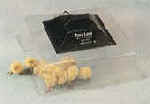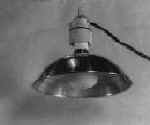Chicks are generally hardy
creatures but they do need certain requisites in order to thrive.
So what is
required?
Warmth and protection
New chicks need a well ventilated, draught-free area to start their lives out of the egg.
In nature, the mother hen supplies the chicks with warmth and security so chicks hatched
artificially need a heat source to avoid chilling and a safe place to grow. This can be as
simple as a household light bulb, but the very best form of heating for new chicks
(besides a hen) is an infra-red emitter. These work by emitting infra-red rays which warm
the floor, walls and other objects which then radiate heat to the chicks. Infra-red light
also promotes healthy growth. The easiest way to check the temperature is to observe the
chicks. If they huddle together right under the heat source and cheep plaintively, you can
bet they are too cold, so you need to lower the emitter until they begin to fuss about
doing chicky things. When the temperature is right, your chicks will be active and will
chirp contentedly. If the temperature is too hot, the chicks will move as far away from
the heat source as possible and will pant and hold their wings away from their bodies. In
this case, the heat source should be raised until they become active and begin to chirp
normally again. Other heat sources can be fuelled by gas or kerosene or electricity.
Chicks can even be raised under a simple light bulb if needs be. It really is that simple.
To keep the chicks near the heat source, some kind of enclosure must be made. This can be
as simple as a cardboard box (for small numbers of chicks) to more elaborate metal or
wooden structures. Ideally the container will be circular in shape, so there are no
corners where the chicks can huddle and smother each other. As the chicks begin to grow,
the enclosure can be enlarged to accommodate the needs of the growing birds. The whole lot
can be housed in a simple garden shed or garage so that predators cannot decimate your
flock.
Food
When chicks first hatch, they are equipped with sufficient nutrition from the egg to last
them up to two days, before they need to take food. Tests have shown that chicks which are
given their first food at 60 hours after hatching tend to grow more rapidly, however
suffered some mortality. Chicks fed at 24 hours after hatching suffered no mortality and
grew only moderately slower than the 60 hour chicks. So it would seem that feeding your
new babies the day after hatching would be the best strategy. Probably the best (and
easiest) food to give new chicks is specially prepared chick starter crumbles. These
products are formuated to supply the correct nutritional needs for baby chicks and are
ready to use straight from the bag. Most brands have an added coccidiostat which prevents
the chicks from contracting coccidiosis which can kill all your chicks quite suddenly.
However, it is still safest to give your chicks regular doses of a sulpha drug to make
doubly sure. You may prefer to feed your chicks on a mash preparation and these are also
available pre-mixed. If you want to push the chicks along a little, perhaps to time their
growth for an important show, you can mix a little meat meal into their food. Be sure not
to feed too much of this or your chicks will grow too quickly and may get joint disorders
such as 'slipped hock'.
After about a week, you can start feeding the chicks some very finely chopped greenstuff.
Lettuce, clover leaf and lucerne (alfalfa) leaf are excellent green feed for chicks.
Water
Chicks also need a ready supply of fresh, cool water. It is important to ensure that the
containers you use are quite shallow as a day old chick can drown in less than one inch of
water. Ideally, the water containers should be spill-proof as damp, muddy floors are a
sure source of disease, particularly coccidiosis. Ensure the water containers are not too
close to the heat source as warm water will cause bowel troubles in the chicks. It is a
good idea to add a little soluble multi-vitamins to the water in the first few days to
give the chicks a great start. Some fanciers also choose to medicate the water with
preventive antibiotics such as Tylan or sulpha drugs. These can prevent outbreaks of
coccidiosis and some respiratory diseases, though they must be used with caution. Over-use
prevents the chicks from building natural resistance to diseases which can cause illness
in the chicks later when they do not have the benefit of the drugs.
Finally, remember as with all baby creatures, gentleness and love are key ingredients in
nurturing chicks to adulthood. |

The Brinsea CosyChick is a small hot air
brooder suitable for a small number of chicks. This model uses simple light bulbs to
generate heat.

An infra-red emitter. This type of brooder is
best but such emitters are often quite expensive.

Feeders and waterers are usually made from
galvanised steel or plastic, which are easy to clean and durable.
|